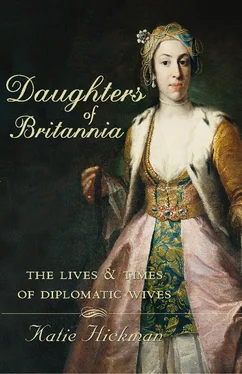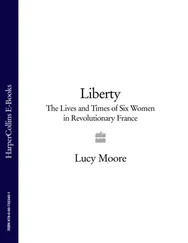This natural affinity with all things Japanese, which began with the natural world, opened Mary’s mind to many other, more perplexing aspects of Japanese life. Throughout her time there she was almost startlingly open to what must have seemed a deeply alien culture. She was strangely aware of the bluntness of her own, western faculties when it came to describing the exquisite delicacy of Japanese sensibilities. ‘English is a clumsy, square-toed vehicle of expression,’ she wrote in exasperation, ‘and stumbles along, crushing a thousand beauties of my Japanese thought-garden, which a more delicate language (or a more skilful writer!) might have preserved for you.’
Very soon Mary learned to love the Japanese people, as well as their country. Her natural peers were ‘the little hot house ladies’ of the imperial court, ‘with their pretty shy ways and their broken confidences about the terror of getting into European clothes.’ * The life of the court was very formal: the clothes, etiquette and food were all strictly regulated. The speech used by the imperial family differed from that of ordinary people. There were special terms for the royal-feminine and the royal-masculine, and courtiers had to take care when speaking to one of the princes to use certain words meant only for royal ears. ‘Is this not a puzzling sum?’ Mary exclaimed. Even when the Frasers attended the Emperor and Empress at Enryo Kwan, their palace by the sea, this formality persisted. A simple walk around the palace gardens was conducted with rigid protocol. Members of the court followed the sovereigns, in the strictest order of precedence, in all their uniforms and finery, ‘like some huge dazzling snake, gliding in and out of all the narrow paths’.
Even the smallest details of imperial life, Mary observed, seemed to have a peculiarly Japanese grace. The chrysanthemum, symbol of the Japanese imperial house, appeared embossed in gold on royal invitations, on the panels of the court carriages, and even on the servants’ liveries. Thursdays were reception days at court and Mary was fascinated by the refreshments offered to the diplomatic corps on these occasions, which included maple leaf shapes made entirely of sugar: ‘Large and small, deep crimson, green and orange, with three leaves, or five or seven, they were piled on the delicate china in such an artistic fashion that I could not refrain from an exclamation of pleasure when they were offered to me,’ she wrote.
Mary was intrigued by the ladies of the court, but she felt greater sympathy for the ordinary people of Japan, particularly her own servants. ‘The very smart people here affect the most impassive countenance and a low voice in speaking,’ she noted, while only the lower classes could express their emotions and joie de vivre , although their habits did sometimes surprise her. She was supposed to enter her servants’ courtyard only at appointed times, but she could not resist observing them from behind the blinds of one of the upper windows. Once, in the terrible heat of summer, when even she could bear no more than ‘the thinnest of white garments’ against her skin, she arrived in her kitchen to find, to her quiet amusement, her cook’s grandmother ‘without a shred of raiment on her old brown body’.
Big Cook San, as her principal chef was known, was a particular favourite. Ever since the influenza epidemic which had swept the country earlier that winter he had suffered from bad lungs, and so when Mary and Hugh went on a visit to Horiuchi, a fashionable seaside summer resort, they took him with them, hoping that the change would do him good.
Big Cook San descended to the platform, jingling like a gypsy tinker with all the saucepans that he had hung round himself at the last moment. An omelette pan and a bain-marie, miraculously tied together, hung over his shoulder; a potato-steamer from his waist; in one hand he carried a large blue tea-pot, and in the other a sheaf of gorgeous irises, carefully tied up in matting, for fear there should be no flowers at Horiuchi!
Mary’s greatest affection, though, was reserved for Ogita, her samurai, guide and interpreter, her ‘right hand in a thousand matters of life’. When he died, of influenza, she recorded his death with real grief. ‘Do you wonder that I tell you so much about a mere servant?’ she wrote. ‘He has been so helpful and faithful, has carried out all my whims with such gentle patience, has piloted me through so many journeys, taught me so many quaint stories, that a part of my Japanese life has died with him.’
Ogita was a tall man of soldierly bearing, a master swordsman and a teacher of Japanese fencing. After his illness Mary was shocked to see death written on the face of this ‘valiant, humble, upright soul’. Ogita lived in a little house in the British legation compound with his wife and five children, and when Mary visited him there and saw him lying on a couple of worn mats on the floor, she thought he looked pitifully long and thin, and much too large for the tiny room. Although he was often too weak to speak, until the very last his two hands always went up to his brow when she entered, and there was always ‘a light of welcome’ shining for her in his eyes. Once or twice he said to her: ‘Okusama * is very kind; I would get well if I could; but I can never travel with her any more, and I am too tired to live.’
After his death, Mary went to visit Ogita one last time. Incense was burning in the house, and freshly gathered flowers had been placed near the coffin head.
He lay very straight and stiff, with a smile of peace on his thin face. His hands were crossed on his breast, and his long blue robes were drawn in straight folds, all held in place with little packets of tea, which filled the room with a dry fragrance; the coffin was lined with these, and his head rested on a pillow of the same. Beside him on a stand lay his most precious possession, his sword; and before the weeping wife left me kneeling there, she touched my shoulder, and pointed to the sword, bowing her head in reverence, and whispering, ‘Samurai, Okusama!’
Mary, a devout Catholic, had tried without success to convert Ogita to her faith. Although she was to remember this with regret after his death, she comforted herself with the thought that he had been ‘a samurai and a gentleman to the last; and I do not believe that any true gentleman was ever shut out of heaven yet.’ 15
When Elizabeth Blanckley arrived in Algiers in 1806, where her father was posted as British consul, it was through her servants, too, that the spirit of the country was most vividly revealed. Not everyone in the Blanckley household was as favourably impressed by their first sight of the country as Elizabeth. Her Maltese nurse was so disconsolate ‘at seeing herself surrounded by turbans’ (from the moment they disembarked, she never ceased weeping and exclaiming, ‘I must die, my heart is broke’; ‘ il mio cuore sta negro, il mio cuore sta negro ’) that the family took pity on her and dispatched her back home. Instead they found a new nurse, Maria; her husband, known as Antonio the Stupid because he could never do anything right; and a butler who could turn his hand to anything, but was particularly adept at making dolls’ wigs. Most exciting of all for Elizabeth and her sister, who were then still quite young, there was Angela, a seventeen-year-old slave, who was presented to them by the Dey (the local ruler) along with her three-month-old baby.
As Christians the Blanckleys were not allowed to own slaves, who were usually hired out to them as domestic servants (Maria and Antonio the Stupid were both slaves of Maltese extraction). Angela and her baby, however, were gifts, which was just as well because ‘the poor helpless unfortunate’ appeared to be unable to do anything at all either for herself or for her baby, let alone in any capacity as a domestic. The Blanckleys, who were good-natured and rather intrigued by her interesting circumstances, took them into their household and cared for them all the same. The baby, who was known as Angelina, became a great favourite.
Читать дальше












